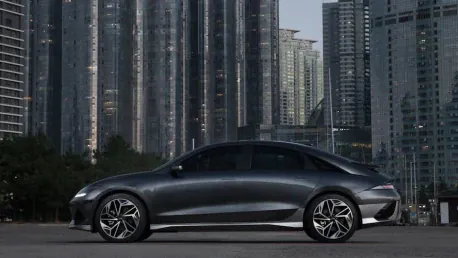One of the primary goals of any business is to achieve sustainable profitability, and for Xpeng, an electric vehicle (EV) manufacturer from China, this target seems increasingly attainable. According to its President Brian Gu, the company anticipates reaching its break-even point by late 2025, a significant milestone that was initially set for 2023. Achieving this goal would make Xpeng the first Chinese automaker to become profitable primarily through EV sales, distinguishing it from competitors like BYD and Li Auto, which rely heavily on hybrid vehicles for their profits. With strong demand for its new models and an expanding international presence, Xpeng is well-positioned to capitalize on this burgeoning market.
Factors Driving Xpeng’s Growth
Demand for New Models
Xpeng’s optimism regarding profitability is largely driven by the strong demand for its latest models, particularly the Mona 03 and P7+. The remarkable reception of these models not only boosts sales but also strengthens the company’s market positioning. The Mona 03, geared towards the budget-conscious yet tech-savvy consumer, embodies Xpeng’s commitment to combining affordability with advanced technological features. Similarly, the P7+, with its premium features and advanced autonomous driving capabilities, appeals to a more affluent customer base looking for luxury and innovation in their EV choice. This diversified product portfolio allows Xpeng to cater to various market segments, ensuring a broader customer base.
In addition to capturing domestic market share, Xpeng is aggressively pursuing international expansion, which is expected to further boost profitability. The company’s fourth-quarter revenue forecasts have already surpassed Wall Street estimates, reflecting strong performance and market confidence. This positive trajectory is expected to maintain its momentum into late 2025, underpinned by Xpeng’s strategic planning and focus on meeting consumer demands. By continuously innovating and introducing models that resonate well with both domestic and international customers, Xpeng sets itself apart from competitors, cementing its leadership in the EV market.
Government Subsidies and Tariff Challenges
Support from the Chinese government plays a crucial role in Xpeng’s market growth, with subsidies of up to $2,800 per trade-in for older or less fuel-efficient cars significantly impacting consumer decisions. These subsidies make the switch to Xpeng’s electric vehicles more financially attractive to potential buyers, thereby accelerating market penetration. Additionally, the subsidies underscore the Chinese government’s commitment to promoting clean energy and reducing carbon emissions, aligning with Xpeng’s mission of pioneering electric mobility solutions.
Expanding into international markets presents both opportunities and challenges for Xpeng. The company plans to introduce four new models in 2025 and broaden its global footprint. However, it will avoid the North American market due to prohibitive tariffs, focusing instead on Europe despite facing tariffs exceeding 20% on sales. Xpeng is exploring various strategies to mitigate these costs, such as local manufacturing or partnership agreements, which could ease tariff burdens and enhance the brand’s competitiveness. Navigating these tariff challenges will require strategic planning and innovative solutions to ensure profitable market entry and sustained growth.
Technological Innovations and Strategic Partnerships
Tech Service Revenue and Volkswagen Partnership
Xpeng’s technological innovations are a critical component of its business strategy, significantly bolstering its revenue streams. In the third quarter, the company’s tech service revenue nearly doubled year-over-year, accounting for over 12% of its total revenue. A major contributor to this growth is Xpeng’s partnership with Volkswagen, which has proven to be highly lucrative. This collaboration not only enhances Xpeng’s technological capabilities but also opens doors for potential expansion beyond the Chinese market. By leveraging Volkswagen’s global presence and expertise, Xpeng can introduce its cutting-edge technology to a broader audience.
The company is committed to expanding this partnership, potentially extending the collaboration to include new markets and technological advancements. Moreover, Xpeng is in discussions with several other players in the automotive industry regarding smart driving technology collaborations. By developing advanced assisted driving systems with large AI models, similar to Tesla’s Full-Self Driving, Xpeng aims to revolutionize the autonomous driving landscape. These systems are expected to debut in China by the first quarter of 2025, positioning Xpeng at the forefront of innovation in the EV sector.
Investment in AI Technology
Investment in AI technology remains a top priority for Xpeng, reflecting its commitment to leading the industry in innovation. In the past year alone, Xpeng has allocated 3.5 billion yuan ($483.07 million) towards AI development. This investment covers various aspects, including computing power and software, essential for advancing the company’s autonomous driving technology. As AI technology continues to evolve, this substantial financial commitment is expected to grow steadily, constituting a significant portion of Xpeng’s overall research and development expenditure.
Looking ahead, Xpeng’s investment in AI is anticipated to yield transformative advancements in intelligent driving and vehicle automation. By integrating sophisticated AI systems into its vehicles, Xpeng aims to enhance the safety, efficiency, and overall user experience of its EVs. This forward-thinking approach not only sets Xpeng apart from its competitors but also aligns with global trends towards smarter, more sustainable transportation solutions. With a strategic focus on AI and technological innovation, Xpeng is well-positioned to achieve its profitability goals and continue its upward trajectory in the competitive EV market.
Conclusion
One of the main objectives for any business is achieving lasting profitability, and for Xpeng, a Chinese electric vehicle (EV) manufacturer, this aim seems increasingly within reach. According to President Brian Gu, the company expects to break even by late 2025, a significant milestone that was initially targeted for 2023. Reaching this goal would make Xpeng the first Chinese automaker to become profitable primarily through EV sales—setting it apart from competitors like BYD and Li Auto, which mainly depend on hybrid vehicle sales to generate profits. Xpeng’s confidence stems from the strong demand for its new models and its expanding presence in international markets. The company is also investing in technology and innovation to enhance its competitive edge. With a focus on developing cutting-edge features and autonomous driving capabilities, Xpeng aims to attract a broader customer base and solidify its position globally. This strategic direction positions Xpeng to take full advantage of the growing EV market.









